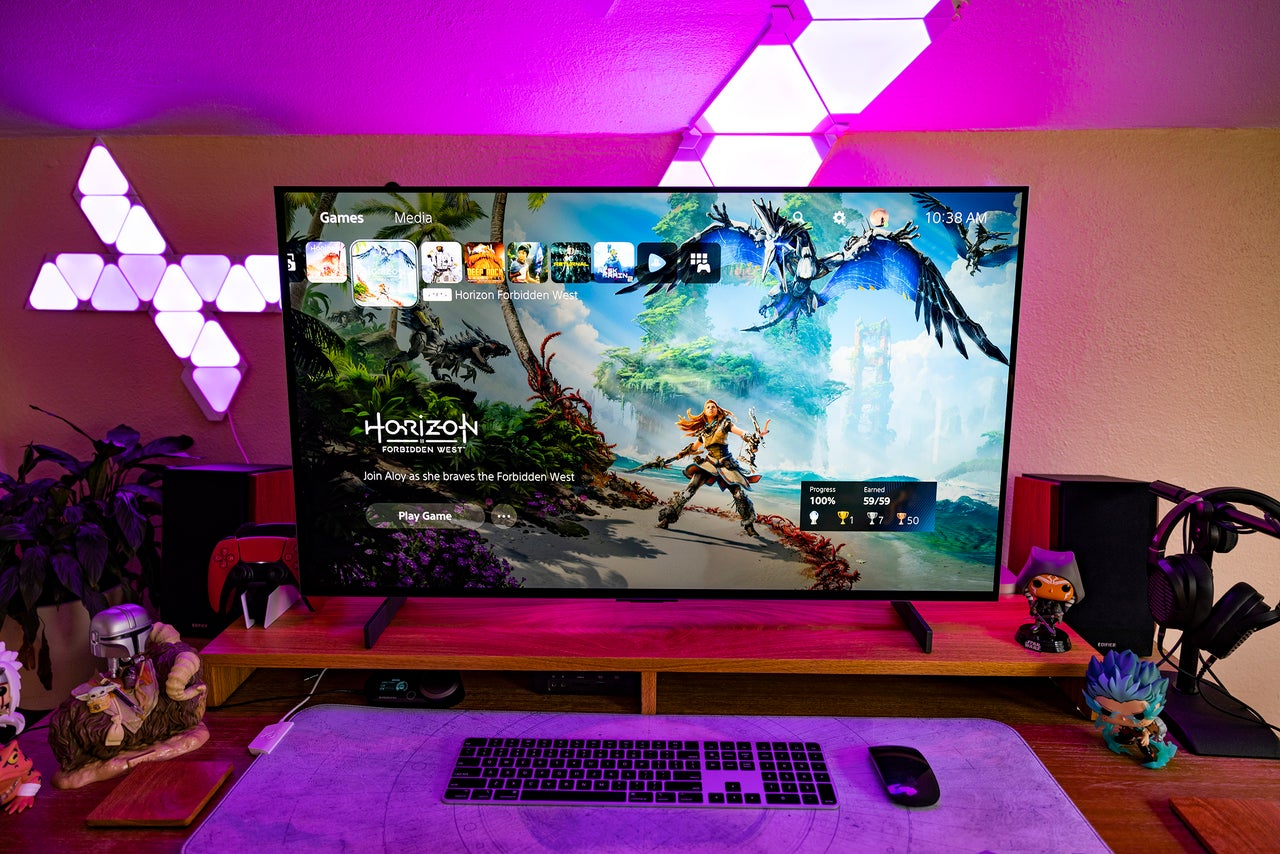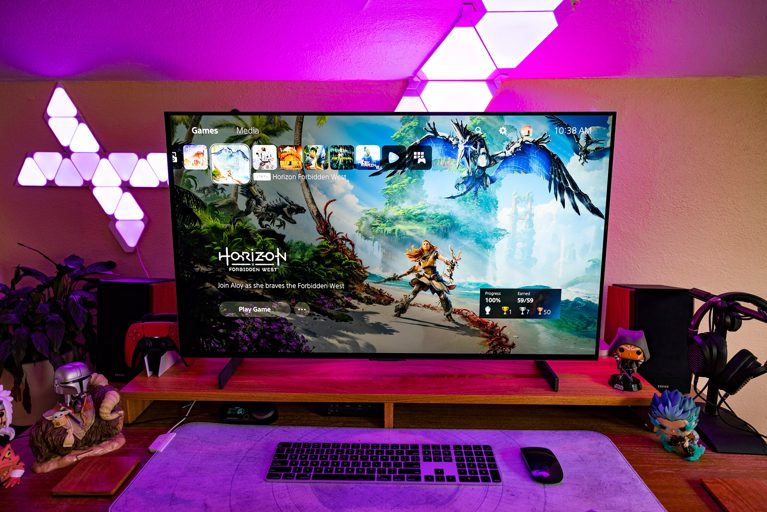## Ditch the Ghosting, Unleash the Vivid: Your Guide to Choosing the Perfect OLED for Gaming
Picture this: you’re locked in a heated battle, every frame a life-or-death decision. Suddenly, a crucial enemy melts through cover, leaving behind a ghostly afterimage that throws off your aim. Frustrating, right? OLED technology promises to banish these visual nightmares, delivering a breathtaking gaming experience with unmatched black levels and lightning-fast response times.

But with so many OLED types vying for your attention, choosing the right one can feel like navigating a minefield. Fear not, fellow gamers! In this comprehensive guide, we’ll break down the nitty-gritty of OLED display technology, comparing various types and highlighting their strengths and weaknesses.

WOLED: LG’s Reign
LG’s dominance in the OLED market stems from its proprietary White OLED (WOLED) technology. This approach involves a layer of pure white OLED pixels, each filtered through a RGBW color filter to produce the desired color output. While this eliminates the individual pixel degradation issues that plagued early OLEDs, leading to a reduction in burn-in risk, WOLED faces its own set of challenges. The RGBW color filter, however, can create inconsistencies in brightness levels across different colors. Imagine shining a spotlight through a series of colored filters – some colors will appear brighter than others due to the varying transparency of the filters. Similarly, with WOLED, the white OLED layer, when filtered through RGBW, can result in imbalanced brightness levels, potentially impacting the overall color volume and vibrancy.
LG has attempted to mitigate this issue with the incorporation of Micro Lens Array (MLA) technology in its higher-end WOLED displays. MLA involves embedding thousands of microscopic lenses on each pixel, effectively focusing the light emitted by the white OLED layer. This helps to distribute the light more evenly, resulting in a more balanced and accurate color representation.
QD-OLED: Samsung’s Quantum Leap
Samsung’s entry into the OLED arena with QD-OLED marks a significant advancement in display technology. Unlike WOLED, which relies on a white OLED layer and a color filter, QD-OLED utilizes a blue OLED layer paired with a layer of quantum dot color converters. These quantum dots are tiny semiconductor nanocrystals that absorb light and then re-emit it at a specific wavelength, effectively converting blue light into red and green hues. This approach eliminates the inherent limitations of RGBW filters, leading to several key advantages.
The absence of a bulky color filter allows for a wider color gamut, resulting in more vibrant and accurate colors. QD-OLED displays also boast exceptional brightness levels, surpassing even WOLED in peak luminance. This superior brightness translates into a more impactful HDR experience, with greater detail and contrast in highlights. Samsung’s QD-OLED technology has the potential to redefine gaming visuals, offering a compelling combination of color accuracy, brightness, and wider viewing angles.
AMOLED: The Versatile Contender
While WOLED and QD-OLED dominate the larger display market, AMOLED (Active-Matrix Organic Light-Emitting Diode) technology holds its own in portable devices like smartphones and laptops. AMOLED’s key differentiator lies in the inclusion of a thin-film transistor (TFT) layer, which allows for individual pixel control. This enables faster pixel response times, resulting in smoother motion handling and reduced motion blur. AMOLED displays are also known for their excellent viewing angles and high refresh rates, making them ideal for mobile gaming.
However, AMOLED’s reliance on TFT technology comes at a cost. While it offers advantages in refresh rates and response times, it sacrifices some of the “infinite” contrast characteristic of WOLED and QD-OLED. This is because the TFT layer introduces a slight amount of light leakage, leading to a less pronounced difference between black and white levels. This is less of a concern in smaller displays, where the user is typically viewing the screen from a closer distance. In larger displays, this light leakage can become more noticeable, impacting the overall contrast and image depth.
Performance Powerhouse
When it comes to gaming, a display’s performance hinges on several key factors: response time, refresh rate, and color accuracy.
Response Time
Response time measures the time it takes for a pixel to change from one color to another. In gaming, a faster response time translates to less motion blur and ghosting, resulting in a sharper and more responsive image. WOLED and QD-OLED generally boast faster response times compared to AMOLED, thanks to their inherent pixel structure. This makes them particularly well-suited for fast-paced genres like first-person shooters and racing games.
Refresh Rate
Refresh rate refers to the number of times per second that the display refreshes the image. A higher refresh rate means a smoother and more fluid visual experience. AMOLED displays often lead the pack in refresh rate, with many models offering 120Hz or even 144Hz refresh rates. This is particularly beneficial for mobile gaming, where fast-paced action and smooth transitions are crucial. WOLED and QD-OLED are also catching up, with several models now offering 120Hz refresh rates, although 144Hz is still relatively rare.
Color Accuracy
Color accuracy is crucial for immersing players in the game world. QD-OLED, with its wider color gamut and precise color conversion, excels in color accuracy. WOLED, while offering good color reproduction, may sometimes fall short compared to QD-OLED, especially in displaying the widest range of colors. AMOLED, with its TFT layer, can sometimes suffer from slight color inaccuracies, particularly in darker scenes.
Budget-Friendly Beasts
The cost of OLED displays can vary significantly based on size, resolution, and technology. QD-OLED currently holds a premium price point compared to WOLED and AMOLED. This is partly due to the newer technology and the complexities involved in manufacturing quantum dot layers.
WOLED, being more established, generally offers a more affordable entry point into the world of OLED gaming. LG’s C-series TVs are a prime example of delivering high-quality WOLED performance at a relatively competitive price. AMOLED, due to its prevalence in smaller devices, tends to be the most budget-friendly option for gamers seeking OLED technology in monitors and laptops.
Beyond the Specs
While technical specifications are crucial, the overall gaming experience also encompasses factors like input lag, motion handling, and HDR performance.
Input Lag
Input lag refers to the delay between a player’s action and its corresponding response on the screen. In fast-paced games, even a slight input lag can significantly impact performance. WOLED and QD-OLED displays generally exhibit very low input lag, making them suitable for competitive gaming. AMOLED, with its faster pixel response times, can also offer low input lag, but it may vary depending on the specific model.
Motion Handling
Motion handling refers to a display’s ability to render fast-moving objects smoothly and without blur. WOLED and QD-OLED, with their fast response times and high refresh rates, excel in motion handling, providing a clear and crisp visual experience for action-packed games. AMOLED’s motion handling is generally good but may not be as exceptional as WOLED and QD-OLED, especially at lower refresh rates.
HDR Performance
HDR (High Dynamic Range) expands the range of colors and contrast a display can reproduce, resulting in a more immersive and visually stunning experience. QD-OLED displays boast exceptional HDR performance, with their wide color gamut and high peak brightness delivering impressive contrast and detail in both highlights and shadows. WOLED, while offering good HDR performance, may not be as impactful as QD-OLED in terms of peak brightness. AMOLED, due to its inherent limitations in contrast, may not fully showcase the potential of HDR content.
Conclusion
So, there you have it: the OLED versus LCD debate in gaming. As we’ve explored, both technologies bring undeniable strengths to the table. While LCDs boast affordability and impressive brightness, OLEDs reign supreme in delivering unparalleled contrast, deeper blacks, and lightning-fast response times that make them the dream choice for a truly immersive gaming experience.
The implications of this choice are significant. We’re witnessing a shift in the gaming landscape, where visuals are becoming increasingly crucial for creating believable worlds and heart-pounding action. OLED’s superior performance isn’t just about pretty pictures; it’s about pushing the boundaries of immersion and responsiveness, leading to a more visceral and engaging gameplay experience. This technology isn’t just the future of gaming displays; it’s the present, and it’s time to step into a world of gaming like never before.
The question isn’t if OLED will dominate, but rather, how quickly we’ll all be captivated by its brilliance.